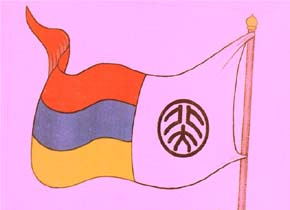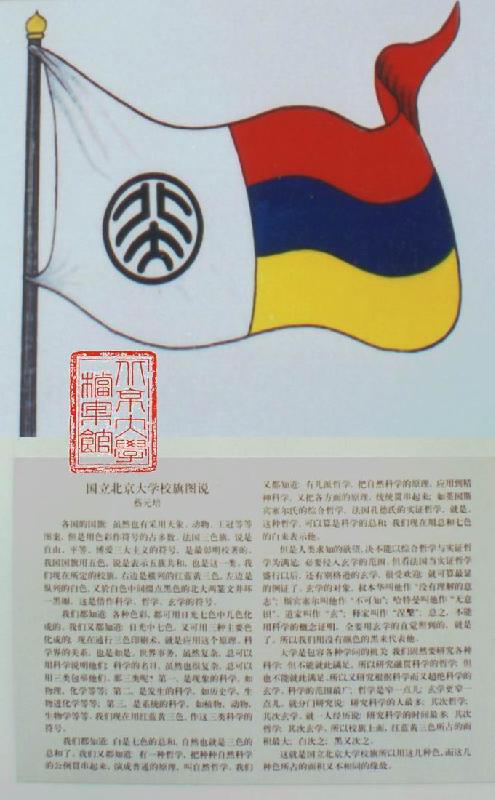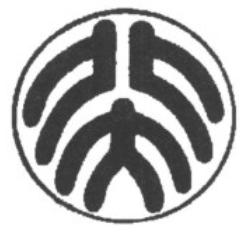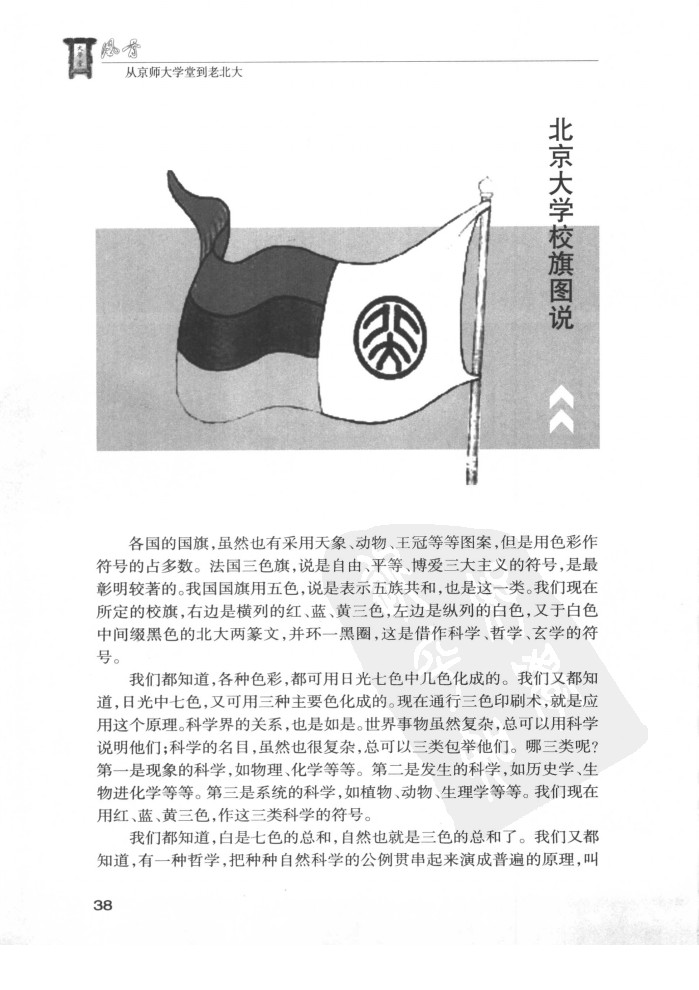News & Events | About PKU News | Contact | Site Search
A special edition of PKU News in commemorating the 113th anniversary of Peking University.
Peking University, May 2, 2011: Cai Yuanpei, then President of Peking University (PKU), wrote a passage titled "Beijing Daxue Xiaoqi Tushuo" (An Interpretation of the PKU Banner) in October 1920, explaining the meaning and significance of the banner. Excerpts follow:

Cai Yuanpei (1868-1940)
Although some are decorated with animals, astronomical phenomena, or crown, most of national flags in the world are decorated with different colors. For example, the national flag of France, known to English speakers as the French Tricolour, symbolizes liberalism, egalitarianism, and humanitarianism. The same goes to the flag of the Republic of China, symbolizing the five largest ethnic groups (Han, Manchus, Mongols, Muslims, and Tibetans) under one union. The PKU banner is featured by horizontal bands colored red, blue, and yellow on the right and vertical band colored white on the left with two black seal Chinese characters "Beida" in a black circle in the middle, symbolizing science, philosophy, and metaphysics.


PKU Banner (File photo/PKU Archives)

PKU Logo (Designed by Lu Xun)
As we know, all kinds of colors can be formed by different combinations of seven colors in the sunlight. The seven colors are mainly combined of three primary colors, which can be applied in three-color printing. The same goes for the relationship in the scientific world. All complex things can be illustrated by science. All the sciences can be classified into three categories: the phenomenal science like physics and chemistry; the occurred science including history and evolutionary biology; the systematic science such as botany, zoology, and physiology. We use red, blue, and yellow as symbols of these three categories.
As we know, white is the combination of all the seven colors, not to mention the combination of the three primary colors. There is one kind of philosophy called natural science that ties together all kinds of sciences to form general principles. There are also certain kinds of philosophy that not only apply the principles of natural sciences into mental science but also tie together principles from all respects, such as Synthetic Philosophy by English philosopher Herbert Spencer and Positive Philosophy by French philosopher Auguste Comte. This kind of philosophy can be regarded as the sum of philosophies. So, we use white as the symbol of it.
However, human being’s appetite for knowledge is too strong to be satisfied. They need not only Synthetic Philosophy and Positive Philosophy, but also metaphysics. The most obvious example is the popularity of Henri Bergson’s philosophy after the prevalence of Positive Philosophy in France. As for the object of metaphysics, Schopenhauer called it incompletely understanding will, Spencer called it agnosticism, Hartmann called it unconsciousness, the Taoist called it mystery, and the Buddhist called it nirvana. In a word, it is what cannot be proved by scientific concepts but by metaphysical intuition. Thus, we use black as its symbol.
The university is a place embracing with various kinds of knowledge. We ought to study various sciences, but that is not enough. So we need to study philosophy that integrates sciences as well as metaphysics which is based on sciences but goes beyond them. Science has the most extensive scope, while philosophy has the narrower and metaphysics has the narrowest. As for the study scale, science has the largest, philosophy has the smaller, and metaphysics has the smallest. People always have spent the longest time on studying science, the shorter time on physics, and the shortest time on the metaphysics. Therefore, red, blue, and yellow have the largest size, white has the smaller, and black has the smallest on the banner.
As all mentioned above, that’s why certain colors appear and have different sizes on the banner.


Excerpts of Cai Yuanpei’s passage "An Interpretation of the PKU Banner" from the book Fenggu: Cong Jingshi Daxuetang dao Lao Beida (Srength of character: from the Imperial University of Peking to early PKU)
Reference:
Xiao Dongfa et al. Fenggu: Cong Jingshi Daxuetang dao Lao Beida (Srength of character: from the Imperial University of Peking to early PKU). Beijing: Beijing Tushuguan, 2003.
Written by: Zhang Hao
Edited by: Su Juan
Source: Agencies